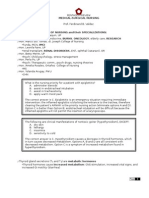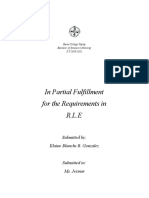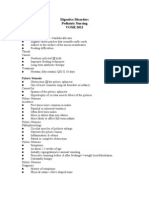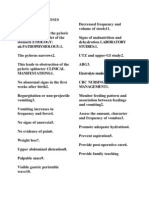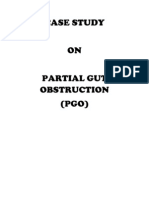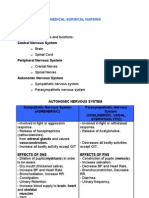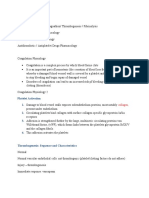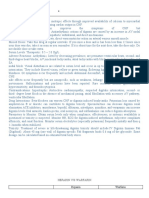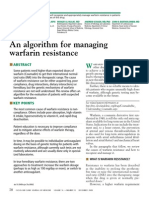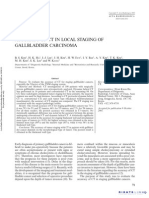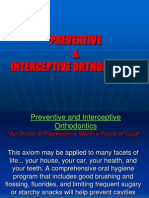Hirsch Sprung
Hirsch Sprung
Uploaded by
Ry AnneCopyright:
Available Formats
Hirsch Sprung
Hirsch Sprung
Uploaded by
Ry AnneOriginal Description:
Copyright
Available Formats
Share this document
Did you find this document useful?
Is this content inappropriate?
Copyright:
Available Formats
Hirsch Sprung
Hirsch Sprung
Uploaded by
Ry AnneCopyright:
Available Formats
Hirschsprungs Disease
Also known asCongenital AganglionicMegacolon. It is the congenital absence of or arrested development of parasympathetic ganglion cells in the intestinal wall, usually in the distal colon. Symptoms are related to chronic intestinal obstruction and usually appear shortly after birth but may not be recognized until later in childhood or (rarely) in adulthood. The lack of colorectal innervation inhibits peristalsis, and the affected portion of intestine becomes spastic and contracted. The internal rectal sphincter fails to relax, which prevents evacuation of fecal material and gas and causes severe abdominal distention and constipation. The most common site affected is the rectosigmoid colon (short segment disease), and the less common is the upper descending colon and possibly the transverse colon are affected (long segment disease). Assessment: o In the neonate: No meconium passed Vomiting bile stained or fecal Abdominal distention Constipation occurs in all patients
Overflow-type diarrhea Anorexia, poor feeding Temporary relief of symptoms with enema o Older child (symptoms not prominent at birth): History of constipation at birth Distention of the abdomen progressive enlarging Thin abdominal wall with observable peristaltic activity Constipation no fecal soiling, relieved temporarily with enema Stool appears ribbon like, fluid like, or in pellet form Failure to grow loss of subcutaneous fat; appears malnourished; perhaps has stunted growth Anemia
Diagnostic Evaluation: Rectal examination demonstrate absence of fecal material in the long segment disease; in short segment disease, rectal impaction may be present and, when the finger is removed, it may cause a rush of stool as the obstruction is temporary relieved. X-rays shows severe gaseous distention of the bowel, with absence of gas in the rectum. Radiopaque markers, when ingested, measure intestinal transit time. Children with short segment disease retain the markers in the rectum for long periods. Barium enema shows narrowed intestine proximal to anus and dilated intestine proximal to narrow segment. Rectal biopsy may be done to demonstrate absent or reduced number of ganglion nerve cells, and confirm diagnosis. Anorectal manometry may be done to record the reflex response to anal sphincter, requires cooperation of the child. Ultrasonogram may be done to demonstrate dilated colon.
Therapeutic Interventions: Enema or colonic irrigation with physiologic saline solution. Older child whose symptoms are chronic but not severe may be treated with isotonic enemas, stool softeners, and a low residue diet.
Surgical Interventions: Initially, a colostomy or ileostomy is performed to decompress intestine, divert fecal stream, and rest the normal bowel. Definitive surgery is done to remove the non-functioning bowel segment with various pull-through procedures (abdominoperineal, endorectal, or rectorectal). Nursing Interventions: Preoperative Assist in emptying the bowel by giving repeated enemas and colonic irrigations. If abdominal distention is not relieved by enemas, discomfort is significant, and rectal tube insertion fails to give relief, consult doctor for a nasogastric (NG) tube. Offer pacifier for infant to suck if on parenteral fluids. Encourage parents to hold and rock the infant. Maintain position of comfort with head elevated. Offer soothing stimulation (eg. music, touch, play therapy). Offer small frequent feedings. Low residue diet will aid in keeping the stool soft. Administer parenteral nutrition if feeding causes additional discomfort because of distention and nausea. For older child, provide demonstration and written and verbal instruction to family for saline enema administration and use of stool softeners. Postoperative Change wound dressing using sterile technique. Prevent wound contamination from diaper. Prevent perianal and anal excoriation by thorough cleaning and use of ointments after the infant soils (postoperative stools can number 7 to 10 per day). Use careful handwashing technique. Report any wound redness, swelling or drainage, evisceration, or dehiscenceimmediately. Suction oral secretions frequently to prevent infection of the tracheobronchial tree and lungs. In older child, encourage frequent coughing and deep breathing to maintain respiratory status. Allow the infant to cry for a short period to prevent atelectasis.
Change position of infant frequently to increase circulation and allow for aeration of all lung areas. Maintain patency of NG tube immediately postoperatively. Maintain NPO status until bowel sounds return and the bowel is ready for feedings as determined by the physician. Provide frequent oral hygiene while on NPO status. Administer fluids to maintain hydration and replace lost electrolytes. Begin oral feedings as ordered. Support the parents when teaching them to care for their childs colostomy. Reassure parents that colostomy will not cause delay in the childs normal development. Involve the entire family in teaching colostomy care to enhance acceptance of body change of the child.
You might also like
- Nursing Practice IDocument7 pagesNursing Practice IFaustine Salas100% (6)
- Pentagon Review Royal PentagonDocument33 pagesPentagon Review Royal PentagonRichard Ines Valino99% (70)
- Psychic Surgery Notes (English, Marathi & Hindi) PDFDocument9 pagesPsychic Surgery Notes (English, Marathi & Hindi) PDFDEEPESH TRIPATHI100% (2)
- MSC Applied Neuroscience Module GuideDocument7 pagesMSC Applied Neuroscience Module GuideThiago OliveiraNo ratings yet
- Word Association TestDocument4 pagesWord Association TestLouRaine TolentinoNo ratings yet
- Fundamentals of Nursing Outline Chapter 46 Potter and PerryDocument6 pagesFundamentals of Nursing Outline Chapter 46 Potter and PerryAidenhunter05100% (6)
- Michael J McCammon - The Power of Herbal Medicine, Iridology and Nutrition PDFDocument161 pagesMichael J McCammon - The Power of Herbal Medicine, Iridology and Nutrition PDFMoga Razvan100% (3)
- Hirsch SprungDocument3 pagesHirsch SprungBheru LalNo ratings yet
- Intussuseption and Hirschprung's DiseaseDocument5 pagesIntussuseption and Hirschprung's DiseaseAris Magallanes100% (2)
- IntussusceptionDocument2 pagesIntussusceptionAireen Mae P. NapigkitNo ratings yet
- Vii. Nursing Care Plans:: Assessment Diagnosis Inference Planning Intervention Rationale EvaluationDocument3 pagesVii. Nursing Care Plans:: Assessment Diagnosis Inference Planning Intervention Rationale EvaluationJasmn DingleNo ratings yet
- Diseases of The NewbornDocument53 pagesDiseases of The NewbornGwynnie TarongoyNo ratings yet
- 2 Common Congenital Anomalies of The GI TractDocument27 pages2 Common Congenital Anomalies of The GI TractZyke NovenoNo ratings yet
- Hirschsprung'S Disease OR Congenital Aganglionic MegacolonDocument59 pagesHirschsprung'S Disease OR Congenital Aganglionic MegacolonHarshika KDGNo ratings yet
- Lecture NCM 109Document11 pagesLecture NCM 109Evangeline Anne MacanasNo ratings yet
- Repro Infant High RiskDocument10 pagesRepro Infant High Riskj UNo ratings yet
- Hirschsprung, S Disease (Mega Colon)Document4 pagesHirschsprung, S Disease (Mega Colon)Freda MorganNo ratings yet
- Week 8 Pedia Pediatric GI DisturbancesDocument110 pagesWeek 8 Pedia Pediatric GI DisturbancesJaja ManezNo ratings yet
- Intestinal ObstructionDocument4 pagesIntestinal ObstructionLenaFrancisNo ratings yet
- INTUSSUSUCEPTIONDocument4 pagesINTUSSUSUCEPTIONFreda MorganNo ratings yet
- Congenital AnomaliesDocument85 pagesCongenital Anomaliesmohammed ragabNo ratings yet
- Nursing Care of The Child With A Gastrointestinal DisordersDocument46 pagesNursing Care of The Child With A Gastrointestinal Disorderstalaekrema01No ratings yet
- INTUSSUSCEPTIONDocument3 pagesINTUSSUSCEPTIONS GNo ratings yet
- Askep HisprungDocument25 pagesAskep HisprungRika AmaliyaNo ratings yet
- Pediatric Care Online AAPDocument18 pagesPediatric Care Online AAPNikola StojsicNo ratings yet
- Elimination 2Document15 pagesElimination 2terrione.kendrickNo ratings yet
- Alterations in Nutrition and GastrointestinalDocument7 pagesAlterations in Nutrition and GastrointestinalChriszanie CruzNo ratings yet
- In Partial Fulfillment For The Requirements in R.L.E: Submitted By: Elaine Blanche R. GonzalezDocument6 pagesIn Partial Fulfillment For The Requirements in R.L.E: Submitted By: Elaine Blanche R. GonzalezBlanche GonzalezNo ratings yet
- Common Acquired and Congenital AnomaliesDocument5 pagesCommon Acquired and Congenital AnomaliesDang SaplanNo ratings yet
- Intussusception: Dr. Narendra Singh Shekhawat Assistant Professor Department of Shalya TantraDocument21 pagesIntussusception: Dr. Narendra Singh Shekhawat Assistant Professor Department of Shalya TantrakhushbuNo ratings yet
- Gastroesophageal RefluxDocument2 pagesGastroesophageal RefluxJustine SuicoNo ratings yet
- Cleft Lip / Cleft Palate: Predisposing FactorsDocument15 pagesCleft Lip / Cleft Palate: Predisposing FactorsMabesNo ratings yet
- Hirschprung DiseaseDocument61 pagesHirschprung DiseaseAdditi Satyal100% (1)
- IntussusceptionDocument24 pagesIntussusceptionOjambo Flavia100% (1)
- Nursing Care of The Child With Gastrointestinal DisordersDocument50 pagesNursing Care of The Child With Gastrointestinal Disordersمهند الرحيليNo ratings yet
- Congenital Anomalies in Newborn (Critical)Document46 pagesCongenital Anomalies in Newborn (Critical)Shereen Mohamed Soliman HammoudaNo ratings yet
- GerdDocument51 pagesGerdHoney LaxNo ratings yet
- PBL No Bowel Output in NeonatesDocument24 pagesPBL No Bowel Output in NeonatesOTOH RAYA OMARNo ratings yet
- 2.large Bowel ObstructionDocument13 pages2.large Bowel Obstructionurmila prajapatiNo ratings yet
- Intussusception: Prepared By: Aisha H. AlaghaDocument20 pagesIntussusception: Prepared By: Aisha H. AlaghaaiooshaNo ratings yet
- Pedia GASTROINTESTINAL DISORDERS Notes FinalsDocument23 pagesPedia GASTROINTESTINAL DISORDERS Notes FinalsgeoellaabcabNo ratings yet
- Hirsch Sprung Disease NewDocument10 pagesHirsch Sprung Disease NewUday KumarNo ratings yet
- 116 Final ReviewDocument194 pages116 Final ReviewAlkiana SalardaNo ratings yet
- Physiology of SwallowingDocument25 pagesPhysiology of SwallowingDyahSavitriKusumoningtyasNo ratings yet
- UntitledDocument2 pagesUntitledKATHLEEN JOY GANOYNo ratings yet
- Disorders of The Gastrointestinal SystemDocument12 pagesDisorders of The Gastrointestinal SystemRonel ResurricionNo ratings yet
- Chapter X.4. Intussusception: Case Based Pediatrics For Medical Students and ResidentsDocument5 pagesChapter X.4. Intussusception: Case Based Pediatrics For Medical Students and ResidentsNawaf Rahi AlshammariNo ratings yet
- 1 - Case Disfagia DisfoniaDocument41 pages1 - Case Disfagia DisfoniaMegan ShanzuNo ratings yet
- Gastrointestinal in ChildrenDocument10 pagesGastrointestinal in ChildrenANNENo ratings yet
- Gastric DisordersDocument135 pagesGastric DisordersEsmareldah Henry SirueNo ratings yet
- Hirschsprung DiseaseDocument14 pagesHirschsprung DiseaseFlordelyn Anuales100% (2)
- Pedia GiDocument10 pagesPedia GiCam IbardolasaNo ratings yet
- Chapter 28 Child With A Gastrointestinal ConditionDocument85 pagesChapter 28 Child With A Gastrointestinal Conditionsey_scottNo ratings yet
- GI HandoutsDocument9 pagesGI Handoutsjeannine_ledesmaNo ratings yet
- Competency Appraisal 1 Reviewer-1Document53 pagesCompetency Appraisal 1 Reviewer-1Paolo Carubio100% (1)
- Diverticular Disease and Intestinal ObstructionDocument31 pagesDiverticular Disease and Intestinal ObstructionPauLa Cheneree Peña ÜNo ratings yet
- Digestive DiseasesDocument10 pagesDigestive Diseaseskate_5182178No ratings yet
- Digestive System Part 1 & 2Document18 pagesDigestive System Part 1 & 2a.rodriguez9796No ratings yet
- Vomiting in ChildrenDocument44 pagesVomiting in ChildrenAstri Faluna SheylavontiaNo ratings yet
- Emergencies in GITDocument7 pagesEmergencies in GITsssajiNo ratings yet
- Pyloric Stenosis WDocument11 pagesPyloric Stenosis WKlaue Neiv CallaNo ratings yet
- Tube FeedingDocument55 pagesTube Feedingrhimineecat71No ratings yet
- Acute Abdominal Pain: DR Naing Naing Oo Senior LecturerDocument28 pagesAcute Abdominal Pain: DR Naing Naing Oo Senior LecturerAbdulrahman NajiNo ratings yet
- Case Study or (PGO)Document10 pagesCase Study or (PGO)Nikki Navalta Dela CruzNo ratings yet
- IntussusceptionDocument4 pagesIntussusceptionlovethestarNo ratings yet
- Dysphagia, A Simple Guide To The Condition, Treatment And Related ConditionsFrom EverandDysphagia, A Simple Guide To The Condition, Treatment And Related ConditionsRating: 5 out of 5 stars5/5 (1)
- Crohn's Disease: AssessmentDocument3 pagesCrohn's Disease: AssessmentRy AnneNo ratings yet
- Nclex ReviewDocument40 pagesNclex Reviewanon-42981396% (27)
- Compilation of MS NotesDocument121 pagesCompilation of MS NotesRy AnneNo ratings yet
- Drugs That Influence CoagulationDocument2 pagesDrugs That Influence CoagulationRy AnneNo ratings yet
- Introduction To Intravenous InfusionDocument8 pagesIntroduction To Intravenous Infusionblndnazi3279No ratings yet
- Community: Heparin V/S WarfarinDocument5 pagesCommunity: Heparin V/S WarfarinRy AnneNo ratings yet
- Compliance With Thromboprophylaxis After Gynecology SurgeryDocument10 pagesCompliance With Thromboprophylaxis After Gynecology SurgeryShahla AlalafNo ratings yet
- Warfarin ResistanceDocument7 pagesWarfarin ResistanceAom PhatchareewanNo ratings yet
- WHO - Tuberculosis - Ethics and Human RightsDocument31 pagesWHO - Tuberculosis - Ethics and Human RightsDavid NathanNo ratings yet
- Peritoneal DialysisDocument12 pagesPeritoneal DialysisSania TohattaNo ratings yet
- Metoclopramide (Reglan)Document1 pageMetoclopramide (Reglan)ENo ratings yet
- General Adaptation SyndromeDocument4 pagesGeneral Adaptation SyndromeGehlatin Tumanan100% (1)
- Female Reproductive System DiseasesDocument2 pagesFemale Reproductive System DiseasesRichard Bueta0% (1)
- Radiological Anatomy For Oncology-2019Document3 pagesRadiological Anatomy For Oncology-2019Asti NastitisukmadewiNo ratings yet
- Endocrine SystemDocument24 pagesEndocrine Systemapi-290318217No ratings yet
- Parent-Child Interaction TherapyDocument6 pagesParent-Child Interaction TherapyScribdTranslationsNo ratings yet
- Accuracy of CT in Local Staging ofDocument6 pagesAccuracy of CT in Local Staging ofRohit KhandelwalNo ratings yet
- Implant (Body Modification)Document4 pagesImplant (Body Modification)Lazlo SecretNo ratings yet
- Acup 123 For Back Pain BlurbDocument5 pagesAcup 123 For Back Pain Blurbhihi12100% (1)
- MDR - GAP ANALYSIS - TS - Q& E - Rev01Document53 pagesMDR - GAP ANALYSIS - TS - Q& E - Rev01Hariom Shukla100% (1)
- Sds Hi 7040 2 After Mixing 2014 11 07Document4 pagesSds Hi 7040 2 After Mixing 2014 11 07henryNo ratings yet
- Growth and Devlopment PrepDocument23 pagesGrowth and Devlopment PrepMai HunnyNo ratings yet
- Muet Speaking SampleDocument4 pagesMuet Speaking SampleYuXuan100% (1)
- The Role of Food in Hospitals: Prepared By: Tracy Murphy Healthcare Consultant May 2017Document20 pagesThe Role of Food in Hospitals: Prepared By: Tracy Murphy Healthcare Consultant May 2017Prasoon PremrajNo ratings yet
- Application of Eye Patch, Shield and Bandage.Document19 pagesApplication of Eye Patch, Shield and Bandage.yaraNo ratings yet
- Slso Lst-Teacher Online LearningDocument5 pagesSlso Lst-Teacher Online Learningapi-467854007No ratings yet
- Psychos Marcin Therapy 2018Document5 pagesPsychos Marcin Therapy 2018cangelescuNo ratings yet
- Preventive & Interceptive OrthodonticsDocument50 pagesPreventive & Interceptive OrthodonticsDeebah ChoudharyNo ratings yet
- 2019 Audit ChecklistDocument27 pages2019 Audit ChecklistChhaiyaAgrawal100% (1)
- DrugwarfactsDocument288 pagesDrugwarfactsapi-267282685No ratings yet
- Routes of Drug AdministrationDocument32 pagesRoutes of Drug AdministrationDawn WRein Legaspi100% (1)

